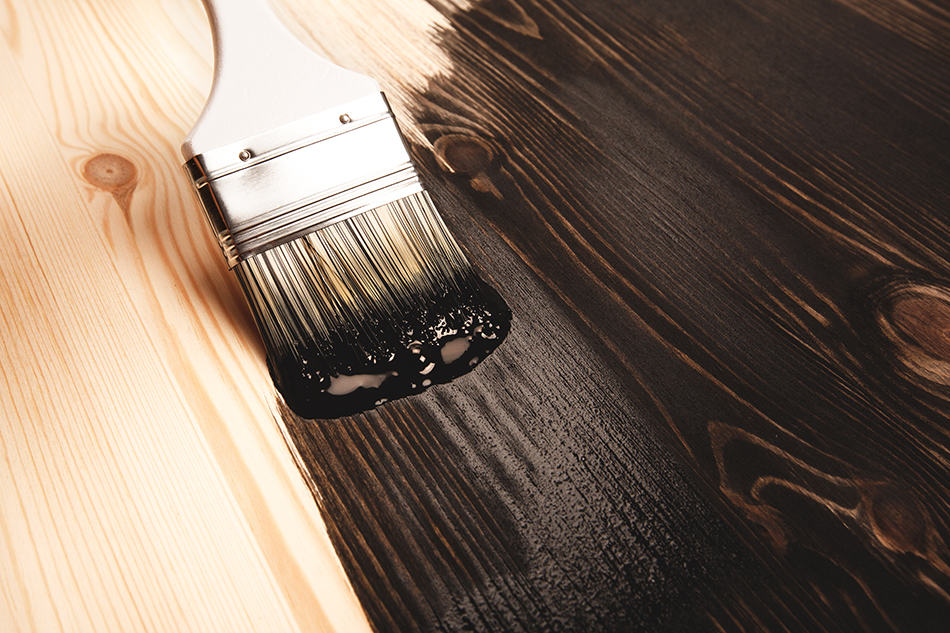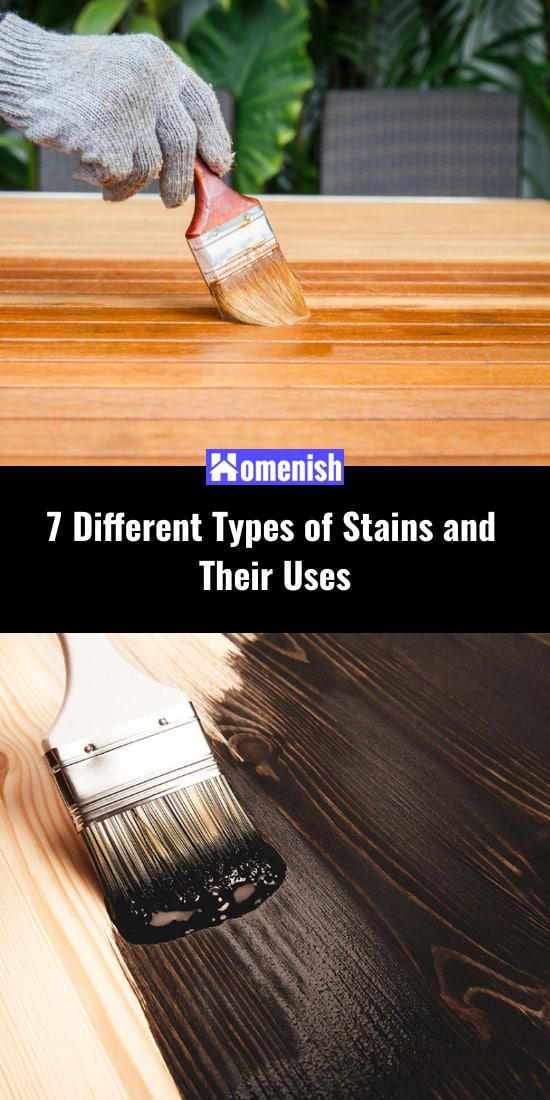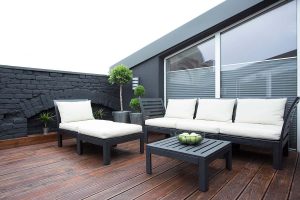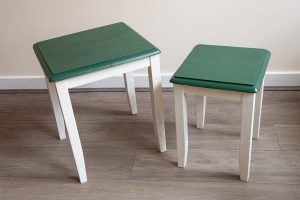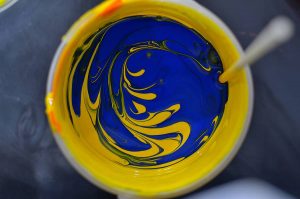Wood stains are liquid colorants that are applied to the surface of the wood to change or enhance its color. Unlike paint, which obstructs the grain of the wood and gives a solid-colored finish, stains allow the grain of the wood to show through and are therefore transparent.
As well as altering the color of the wood and transforming its look, stains can help to preserve the wood, condition it, and protect it against spills, scuffs, and chips. The type of stain most suitable for your project will depend on a number of factors.
Learn about the different types of stains, their properties, and their uses here.
Oil-based Stain
Oil-based stains are the most popular type of wood stains commercially available, and they make up the majority of wood stains you are likely to see on the shelf at your local hardware store. Generally, oil-based stains have a formula that is based on linseed oil.
This helps the stain penetrate deep into the wood and gives the wood a smooth and even finish without brush strokes.
Linseed oil is completely natural and non-toxic, and it is considered to be one of the best preservatives to treat raw wood with, so when you use an oil-based stain, you are helping to condition and preserve the wood as well as staining it.
If you are looking for a completely natural oil-based stain, this is possible, but check the label because many also have varnish or additional binders added to the formulation.
Oil-based stain offers the advantage of improving the durability of your wood and helping to protect it against scuffs and scrapes. It is fairly slow drying, which can be a benefit when you are applying the stain because it allows you to spread the stain to get an even finish and to brush in any drips.
However, the slow drying element of oil-based stain can be frustrating when you have to wait many hours before being able to apply another coat.
Oil-based stain can be used to finish your wood, or it can be used underneath a final coat of varnish or other covering. The only thing which cannot be used on top of an oil-based stain is a water-based finish, as the oil repels the water.
Oil stains can be messy to work with, and you need to use proper cleaning supplies, such as paint thinners, to clean your brushes or other equipment you have used. Oil-based stains come in a huge variety of colors and can be purchased for use on internal or external wood.
Pros:
- Durable
- Preserves wood
- Even finish
- Penetrates deeply
Cons:
- Dries slowly
Water-Based Stain
Water-based stains tend to be the least messy because the water base means they clean up well. You’ll be able to clean up your equipment with warm, soapy water and won’t find long-lasting stains on your skin. They don’t contain pollutants and smell much less offensive than oil-based stains.
If you want a stain that is easier on your eyes, nose, and throat, then a water-based stain would be a good option.
These types of stains have a formula that greatly reduces your exposure to solvens, so they are ideal to use if you have children in the home and don’t want to subject them to harmful VOCs. Water-based stains dry quickly, and though this might seem like an advantage at first glance, it can make the application of the stain quite tricky.
If you are working on a large area, such as a wooden floor, the best tactic is to break it up into sections and work each section at a time, applying the stain and then wiping off the excess with a cloth before moving on to the next section.
One problem people find when using water-based stains is that they raise the grain of the wood. This is a difficult issue to remedy after you have stained the wood because sanding the grain down will inevitably mean some of the stains gets sanded away, and you’ll have an uneven finish.
The best way to address this problem is to apply a coat of water to the wood the day before you plan to stain it. Allow it to dry, and you’ll see the grain has raised. You can then send back the grain before applying the stain. The water-based stain will then not raise the grain any further, and you’ll get a much smoother finish.
Most often, water-based stains are used underneath a water-based finish. You can not pair water-based stains with an oil-based product as they do not mix well, and it can take several weeks for them to dry. Unlike oil-based stains, water-based stains do not penetrate the wood deeply and therefore don’t offer great protection for your wood.
Pros:
- Less irritating smell and fumes
- Dries quickly
- Easy cleanup
Cons:
- Less durable
- More time consuming
- Shallow penetration of wood
Lacquer Wood Stain
Professional woodworkers most often use lacquer stains because they are quite difficult to work with but result in an excellent finish. Despite their name, they do not use lacquer as a binder.
Instead, these stains are so-called because they are suitable for mixing with lacquers to create toners, which can be used in between coats to enhance the color. Instead, the binder in a lacquer wood stain is a short-oil varnish.
These types of stains dry incredibly quickly, which is another reason why they are so popular with professionals. Typically the next coat of stain can be applied just fifteen minutes after the first coat, meaning that staining jobs can be completed super fast.
Because of the ultra-speedy drying time, people will usually work in pairs to apply a lacquer wood stain, with one person spraying on the stain while the other person trails behind them and wipes off the excess almost immediately.
Mistakes cannot be corrected due to the fast drying time, which makes this product a risky idea for anyone not experienced in applying wood stains. If you do attempt to use a lacquer wood stain, ensure you have somebody working with you throughout the process.
Another problem with the fast drying process of this stain is that air bubbles can form in the lacquer wood stain and will remain on the dried piece of wood. The best way to ensure this doesn’t happen is to thin the consistency of the stain with lacquer or prevent any temperature changes while the stain is drying.
Lacquer wood stains have many advantages, but one of the main drawbacks is the fact that these stains contain a lot of chemicals.
Typically they will be made from ketones and xylene solvents, and the stain will have a very strong odor. For this reason, only ever use lacquer wood stain in an open space, or somewhere that is very well-ventilated.
Pros:
- Dries quickly
- Can be mixed with lacquer
- Smooth finish
Cons:
- Can be hard to use
- Strong odor and solvent fumes
- Bubbles can form
Gel Stain
Gel stains tend to be oil-based, which gives them similar advantages to ordinary oil-based stains, such as conditioning and preserving the wood and penetrating deeply. However, gel stains have one important advantage over other stains, and this is its gel-like consistency.
Gel stains are very thick, with a consistency comparable to hair gel or mayonnaise. While this can make application something of a learning curve because the consistency is probably unlike anything you’ve used before, once you’ve gotten used to using the product, it’s very easy to apply, and most importantly, it completely removes the chances of blotching occurring on the wood.
Blotching is a common problem, especially when staining pine wood, and it results in an uneven finish with darker and lighter patches where an uneven amount of resins have settled into the wood.
Typically when this happens, the only way to fix it is to sand back the wood to its original state, which can be very time-consuming and labor-intensive.
One alternative to prevent blotching is to apply a wood conditioner before applying the stain, but this means purchasing two different products and having to apply both instead of just one.
Gel stains prevent the issue of blotching and ensure that your results will be reliable and predictable, and it is much more convenient to apply than several different products to tackle the problem.
Another advantage of gel stain is that the thicker consistency means drips won’t occur and ruin the look of your finished project, which can happen with many other types of stains. The consistency of gel stain does, however, mean that it needs to be applied by hand and cannot be sprayed on like other stains.
As gel stains are generally oil-based, cleanup will require mineral spirits to prevent brushes and cloths from drying hard.
Like standard oil-based stains, gel stains have a relatively long drying time, but this can be seen as an advantage if you are not in a hurry to finish your project, as it can give you extra opportunity to correct mistakes.
Pros:
- Prevents blotching
- Preserves wood
- Even finish
- Won’t drip
Cons:
- Slow drying
- Can be messy
- Cannot be sprayed
Water Soluble Dye Stain
Water-soluble dye stains come in the form of powder sachets; they are so-called because to create the stain, you need to dissolve the powder into water. This type of stain was originally developed to dye textiles but was later adapted to make it suitable for use on wood.
Water-soluble dye stains, also known as aniline dyes, were very popular amongst furniture makers in the first half of the 20th century, but the advent of metal complex dyes in the 1950s meant that the popularity of water-soluble dyes diminished.
Today, these types of dyes are most commonly used by amateur woodworkers or small carpentry workshops because they offer a number of benefits.
Water-soluble dye stains come in a wide choice of colors which can easily be adjusted slightly to make them more or less vivid by altering the amount of water used to create the stain.
This is one of the reasons water-soluble dye stains remain popular among users because of the huge array of colors which can be achieved and the control that the user has over the final finish of the stain.
You can even alter the color of the stain after it has been applied and dried. If you want to create a more intense color, then add more layers of the dye stain, or if you want to lighten the shade, then wipe over the wood with a damp cloth to water down the dried stain.
You could also change your mind and add a completely different color dye to the wood. For example, if you have used a red dye stain, then you could add a blue dye stain over the top to achieve an end result of purple-stained wood. Or add a yellow layer to a blue-stained piece of wood to achieve a final result of green-stained wood.
Another thing to note about water-soluble dye stains is that no matter how dark or intense the color of the stain is, it will always allow the grain of the wood to show through, unlike some other types of stains, which can give such intense results that the wood can almost look as though it has been painted.
If you are keen to enhance the grain of your wood rather than disguise it, then water-soluble dye stains would be a good option.
To mix your water-soluble dye stain, dissolve the powder in water at a ratio of around one quart of water to one ounce of powder. This can be adjusted depending on how intense you want the color of your stain to be.
If you wish to create a very intense color and will need to dissolve a lot of powder in the water, then use hot water as this will allow a greater amount of powder to dissolve compared with cold water.
The minerals and metal residues in your tap water can affect the color of the final stain, so if you have a particularly high level of these, then you may want to use distilled water.
This type of stain does not go off and has an unlimited lifespan in powder form, as well as in liquid form once it has been mixed, so if you have any leftover after a completed project, you can store it for use at a later date to prevent waste.
The biggest drawback with water-soluble dye stains is that their colors fade in UV lighting. This means that if your stained wood will be in direct sunlight or fluorescent lighting, then you are likely to witness a gradual fading of the stain over time.
Pros:
- Increased user control over color and finish
- Wide color choice
- Unlimited lifespan
- Doesn’t obscure wood grain
- Easy to use
Cons:
- Fades in UV light
Varnish Stain
Varnish stains use varnish as the binding agent, which is often polyurethane varnish. This is a type of liquid plastic, which will give the wood a durable and protective layer against scuffs and chips. Varnish stains dry completely hard and strong, with a glossy finish.
Depending on the formula of the varnish stain, your finished wood will be heat resistant and have a good level of protection against chemical or acid spills, for example, cleaning products. This hard finish means that, unlike oil stains, varnish stains do not need to have the excess wiped away after application and can instead simply be painted or rollered onto the wood surface and left to dry.
Varnish stains offer easy application due to this, and they also mean fewer products have to be applied to the wood. Most stains, including oil stains, will need to have a final finishing coat applied to make them more durable and seal the stain.
However, varnish stain is both the stain and finishing varnish in one product and, therefore, saves the user from having to use multiple products.
The drawback of this is that the finish can look uneven or splotchy because the varnish stain does not have the excess wiped away as you would with other types of stains.
This means that the application needs to be very careful to avoid areas on the wood where the varnish is thicker or thinner in order to achieve a good result. Another issue with varnish stains is that, over time, they can turn yellow, giving your wood an unattractive look.
Pros:
- Simple application
- Dries hard and strong
- No need for finishing coat
- Water-resistant
Cons:
- Finish can be uneven
- Yellows over time
Metalized Dye Stain
This type of dye stain was developed in the 1950s as an alternative to water-soluble dye stain. The main issue with water-soluble dye stain was that the color faded in UV lighting, and though metalized dye stain can still fade, it does so much more gradually, giving the product it is used on a longer life span.
Metalized dyes are usually purchased in a ready-to-use form, but they can also be found in concentrated form for mixing with the user’s choice of thinner.
Methanol was once used as the thinner in ready-mixed metalized dyes, but acetone is now the standard thinner used. For home mixing, you could mix the concentrated dye stain with acetone, water, alcohol, or lacquer thinner.
One of the main advantages of these stains is that they do not raise the grain of the wood and, in fact, are sometimes known as NGR stains, which stands for ‘non-grain raising. The exception to this is if you mix the concentrated metalized dye stain with water, as this will cause the grain of the wood to be raised.
Metalized dye stains are popularly used with a sprayer in industrial settings because they dry so rapidly.
This is an advantage for projects that need to be completed quickly because a finishing coat can be applied in as little as fifteen minutes after the metalized dye stain. For use at home or by amateur woodworkers, the quick drying time can be problematic unless the project is very small.
Pros:
- Quick-drying
- Won’t raise grain
- Even finish
- Comes pre-mixed or concentrated
- Less susceptible to fading from light
Cons:
- Best suited to industrial use
What is the Best Type of Stain?
The answer to this question depends on your priorities and what you want from your stain. If you have young children living in the home where the stain will be used, then you may feel the low presence of fumes is more important than a durable finish, and so, in this case, a water-based stain would be best.
If VOCs aren’t an issue for you, and you’re not a professional woodworker, then an oil-based stain is the easiest to use and will give a durable finish. If you’re looking for the final finish to be glossy, then opting for a varnish stain would be best, as this product combines both the stain and varnish in one to make for a hassle-free application.
If you are staining pine, then the ideal stain to use would be a gel stain in order to achieve the most even finish and avoid blotching.
For commercial use and to stain most wood in the shortest amount of time, a metalized dye stain or a lacquer wood stain works best, as these dry in a matter of minutes to allow the final coat to be added almost instantly.
If color control is your priority, then you should consider water-soluble dye stains, as these can be adjusted even after the stain has dried if you change your mind or aren’t happy with the result.
